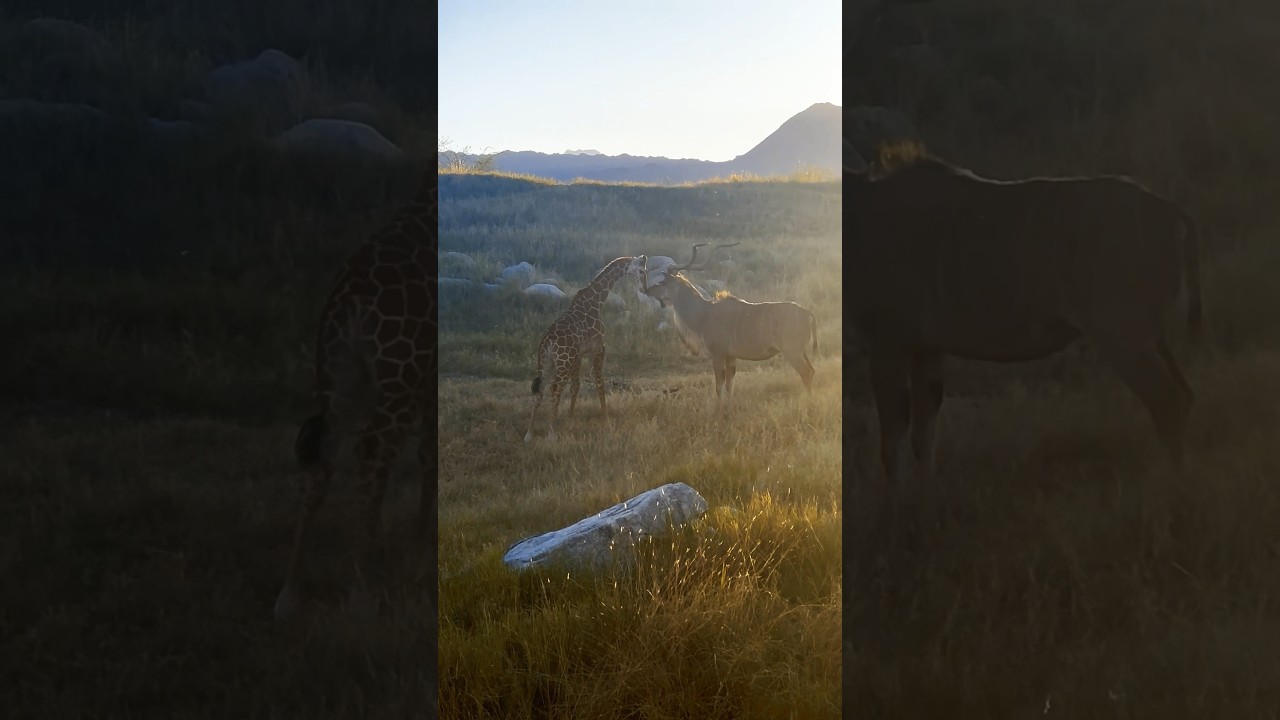– The natural behaviors and characteristics of baby giraffes and greater kudus
– The ecological importance of first encounters between different species
– Methods of wildlife conservation and the role of zoos
– The impact of human activities on giraffes and kudus
When a baby giraffe and a greater kudu meet, it’s not just an endearing moment captured on video; it’s a fascinating event that offers deep insights into animal behavior, ecology, and conservation. These rare meetings provide a unique window into the interactions between different species in their natural habitats. By examining such interactions, we better understand the complexities of wildlife behavior and the importance of preserving biodiversity.
### Natural Behaviors and Characteristics
Baby giraffes, with their long necks and legs, are among the most recognizable animals in the world. From birth, they are designed to survive in the challenging environment of the African savannah. They are precocial, meaning they are born in a more advanced state of development – able to stand and walk within hours of birth. This rapid development is critical for escaping predators. The greater kudu, in contrast, is one of the largest antelopes, distinguishable by their impressive spiraled horns found in males and their elegant, striped bodies. While they share habitats, the behavioral patterns of giraffes and kudus differ significantly, influenced by their distinct ecological niches.
The first encounter between a baby giraffe and a greater kudu is heartwarming and demonstrates the curiosity inherent in many young animals. This curiosity leads to learning opportunities that are essential for their survival. Observing how these two species interact can teach us about their social structures, communication methods, and adaptability.
### Ecological Importance of First Encounters
Interactions between different species, such as those between baby giraffes and greater kudus, are pivotal for maintaining healthy ecosystems. These encounters can affect food chains, breeding patterns, and plant life, influencing ecological balance. For instance, giraffes’ grazing patterns can lead to changes in vegetation structure, which in turn may affect the food availability for species like the greater kudu.
Understanding these interactions is critical for conservation efforts. It helps scientists and conservationists anticipate the consequences of changes within ecosystems, such as those caused by climate change, habitat loss, and the introduction of invasive species.
### Wildlife Conservation and the Role of Zoos
The preservation of species like giraffes and kudus requires a multifaceted approach. Wildlife conservation efforts focus on protecting habitats, research, and education. Zoos play a crucial role in these efforts. They serve as centers for conservation science and public education, working to raise awareness about the challenges facing these species and their habitats. By showcasing the captivating interaction between a baby giraffe and a greater kudu, zoos can foster a connection between visitors and wildlife, inspiring people to support conservation initiatives.
Responsible zoo management emphasizes the well-being of the animals, providing environments that replicate their natural habitats as closely as possible. This approach ensures that species like giraffes and kudus can exhibit natural behaviors even in captivity, which is crucial for their physical and psychological health.
### Impact of Human Activities
Human activities have profound effects on wildlife. Habitat destruction, pollution, and climate change pose significant threats to the survival of many species, including giraffes and kudus. Deforestation and urban expansion reduce the available natural habitat, while climate change alters the ecosystems that these animals depend on. Illegal poaching, although more often associated with elephants and rhinos, also affects these species directly through hunting and indirectly by increasing their vulnerability due to habitat loss.
Conservation strategies must address these challenges to protect giraffes, kudus, and other wildlife. This includes creating and maintaining protected areas, enforcing anti-poaching laws, and promoting sustainable practices among local communities. Public education is also vital, making people aware of the impact of their actions and how they can contribute to conservation efforts.
In documenting and sharing the moment a baby giraffe meets a greater kudu, we highlight the magical encounters that occur in the wild and the pressing need to protect these remarkable animals and their habitats. Through understanding, appreciation, and action, we can ensure that future generations will witness the wonder of such interactions. By supporting wildlife conservation, we play a part in preserving the intricate fabric of life on our planet, which is essential for the well-being of all species, including humans.
*****
Source Description


